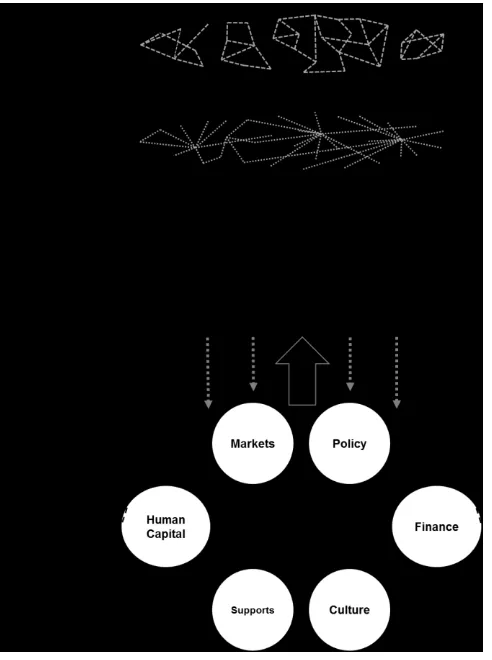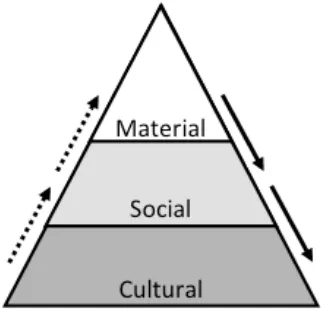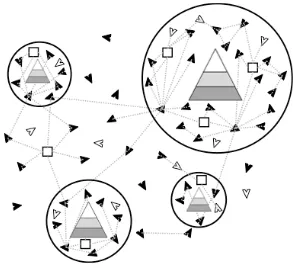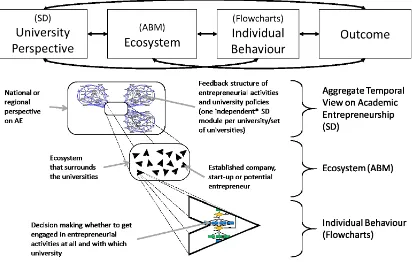1
The Dynamics of Academic Entrepreneurship: Connecting
Universities and the Ecosystem
Bernd Wurth1,2 *, Susan Howick1, Niall MacKenzie2
1University of Strathclyde, Department of Management Science, 130 Rottenrow, Glasgow G4 0GE 2University of Strathclyde, Hunter Centre for Entrepreneurship, 130 Rottenrow, Glasgow G4 0GE
*Corresponding author, email addresses: bernd.wurth@strath.ac.uk, susan.howick@strath.ac.uk, niall.mackenzie@strath.ac.uk
Abstract
To advance the field of academic entrepreneurship, the system, university and individual level can no longer be treated separately but need to be described and understood as an ecosystem in order to identify drivers and understand the dynamics. This conceptual paper proposes a framework based on feedback thinking, aggregation and complex adaptive systems that connects the university’s and the business’ perspective. A hybrid model with an integrated system dynamics (SD) / agent-based modelling (ABM) approach will then be proposed to operationalise the framework, in which universities are represented as SD modules that shape the environment for the established companies and start-ups,
represented as a set of agents. The SD feedback structure acknowledges and reflects the consequences of entrepreneurial activities for and the influence of the ecosystem on the university. First, this framework advances our understanding of ecosystems by formulating a theoretical foundation for an ecosystem model that is capable of representing the
interactions between its components. Furthermore, it will allow for the examination of dynamic interplays between universities and their ecosystem. The insights from this model have far-reaching implications for universities, intermediate organisations and policy makers at national and regional levels. Further research trajectories are outlined.
Keywords
Entrepreneurial university; Ecosystem; Academic entrepreneurship; Complex adaptive systems; Feedback; Aggregation
1. Introduction
2 particular knowledge and technology transfer channels and the entrepreneurial university as a whole. In addition, universities can create entrepreneurship ecosystems and foster their development even in weaker economic context (Graham, 2014). The existing literature on the dynamics of academic entrepreneurship, the development of the ecosystem and the dynamic interplay with the university is, however, limited.
The ecosystem concept implies that neither firms nor universities or other institutions work in isolation; there is a constant exchange of information and knowledge as well as competition among members of the ecosystem. The sustainability of the ecosystem is crucial to both types of members, for-profit companies as well as non-profit institutions like universities. The dynamic nature of this interplay between the university and its ecosystem makes it hard to grasp. Nevertheless, it is crucial to understand these dynamics for universities, public policy makers and even businesses to develop and implement strategies and policies accordingly. Academic entrepreneurship and the role of universities get a lot of attention from the
academic community, but the vast majority of research methods that are applied are not able to deal with dynamic behaviour and feedback. This paper focuses on the question: what are the dynamics of academic entrepreneurship and the role of the entrepreneurial university within an ecosystem? To answer this question, a framework will be developed and transformed into a simulation model that, eventually, will be able to generate dynamic behaviour based in certain parameters.
The remainder of this paper is structured as follows. The next chapter will provide an overview of academic entrepreneurship as well as the ecosystem concept and the involvement of universities. Following this, complex adaptive systems, aggregation and feedback thinking will be introduced. A conceptual framework will be developed to model the embedment and the interplay between universities and their ecosystem, including a proposal for a simulation approach. Concluding remarks and further research trajectories will end this paper.
2. Academic Entrepreneurship and the University Ecosystem
Many universities underwent significant changes over the last decades. External pressure, such as a decrease in public funding, and internal motivation have led to the development of the “third mission” in addition to teaching and research (Tijssen, 2006). This third mission has widely been recognised as “a mechanism for important research results to be
3 additional industrial research support, and a source of unrestricted funds for additional research” (Carlsson & Fridh, 2002, pp. 3-4).
Historically, there has been and focus on intellectual property (IP) management, i.e. invention disclosures, patenting as well as evaluation and marketing, and eventually
licensing to, mainly established, firms. Universities have, however, diversified their research commercialisation activities, including the creation of start-ups and spin-offs, contract research or consulting. Furthermore, universities have developed means to exchange knowledge and engage companies, entrepreneurs and the third sector without a direct economic benefit (Grimaldi, Kenney, Siegel, & Wright, 2011; Siegel, 2013). The result of a broad portfolio of entrepreneurial activities (Kalar & Antoncic, 2015).
There is no consistent use of key terms such as academic entrepreneurship or
entrepreneurial activity throughout the literature. Figure 1 presents an overview of the
notation that will be used in the course of this paper. Academic research is the origin and the results and expertise gained becomes available for academic entrepreneurship. Academic entrepreneurship (AE) serves as the umbrella term for all entrepreneurial activities. Abreu and Grinevich (2013) developed a framework by categorising entrepreneurial activities with regard to the protection of intellectual property (IP) that is to be transferred. This framework has been adopted and modified with respect to the categorisation variable, which is now simply whether an entrepreneurial activity has an intended economic benefit or an indirect economic benefit. A similar differentiation between engagement and commercialisation has been developed by Perkmann et al. (2013). The benefit of this framework is that it provides a basic overview independent from the involved IP, the importance of which is declining
anyway (Abreu & Grinevich, 2013), and serves as basis for investigating the interplay of particular activities.
4
Figure 1: Academic entrepreneurship and entrepreneurial activities (adapted from Abreu and Grinevich (2013))
In addition to the evolution from technology transfer to the entrepreneurial university that performs a variety of entrepreneurial activities, these activities are no longer viewed as linear, one-way processes. As Philbin (2008, p. 513) describes, “linear process models may appear as overly simplistic; they may infer a lack of feedback or control; or may fail to properly capture the inherent complexity of a dynamic or adaptive process.” The underlying perceptions correspond to what is known as event-oriented thinking as opposed to feedback thinking.
In management and organisational studies, feedback thinking has been applied extensively in the area of organisational learning. Senge (2006), for example, uses systems thinking and system archetypes in particular to help companies become learning organisations. Argyris and Schön (1974, 1978) focused on the notions of single-loop and double-loop learning, the latter having the opportunity to go beyond adaptive learning and alter the theory of action of individuals. Cope (2003, 2005) has transferred these theories and constructs to explain entrepreneurial learning, i.e. the learning process of entrepreneurs. Based on the definition of learning as “an ongoing, dialectical process of action and reflection” (Marsick & Watkins, 1990, p. 8), Cope (2005, p. 392) characterises the dynamics of entrepreneurial learning as “metamorphosis, discontinuity, and change”. Beyond this, feedback thinking has been used to modify existing and create new frameworks for outlining future trajectories in
entrepreneurship research in general (Shepherd, 2015).
5 (Youtie & Shapira, 2008, p. 1191). However, the vast majority of methodologies used to conduct research in the field of academic entrepreneurship that goes beyond theoretical work remains event-oriented rather than based on feedback thinking. Particularly with regard to the drivers of academic entrepreneurship and the dynamic interplay with the ecosystem, this is not enhancing our understanding. It was previously argued that the absence of
longitudinal datasets limited further research (Rothaermel et al., 2007), but this is no longer a valid argument as comprehensive datasets have been collected for the U.S., the UK as well as other parts of Europe and researchers have used this data (Mosey & Wright, 2007; Rasmussen & Borch, 2010; Rasmussen, Mosey, & Wright, 2011).
The concept of the entrepreneurial university already shows that a systematic approach is necessary rather than a focus on individual activities and partners. The need for new approaches to tackle dynamic relationships will increase even more in the future. In fact, Audretsch (2014) describes the entrepreneurial only as an intermediate step towards the
university for the entrepreneurial society. This goes hand in hand with the general trend in today’s society of increasing interaction and a higher level of interconnectedness (Barabási, 2014).
Parallel to these developments, another research trajectory has emerged in the wider field of business, management and public (or economic) policy. Adopted from biology, the term “ecosystem” was first introduced by Moore (1993, 1996) and has become increasingly popular in the business and management literature. Biological ecosystems consist of heterogeneous, interdependent species that interact with each other and their environment and co-evolve. Business ecosystems are comprised of companies that vary in size, age, product/service offerings, industry, etc. and other organisations and service providers such as universities or research institutes. This set of heterogeneous entities form a vibrant network in which they collaborate and compete, and by extension co-evolve like their biological counterparts (Autio & Thomas, 2014; Basole, 2009; Lusch, Vargo, & Tanniru, 2010; Mäkinen & Dedehayir, 2012; Moore, 1993).
Researchers and practitioners have developed the notion of entrepreneurship ecosystems1
in recent years. Isenberg (2010) provided a framework based on six main pillars: markets, policy, finance, culture, supports and human capital. Spigel (in press) characterises
ecosystems based on three sets of attributes in a hierarchical layout. Cultural attributes, as the foundation, support social attributes, which will further support material attributes. On the other hand, these material attributes reinforce the social attributes, which will further
6 reinforce the cultural attribute. Some universities benefit from a strong surrounding
ecosystem, while others are embedded in weaker regions. Focusing mainly on the latter, Graham (2014) describes how universities can establish their own entrepreneurship ecosystem. This acknowledges that ecosystems are not given but can and must be developed.
[image:6.595.177.423.299.629.2]The ecosystem of a particular university is to some extent the combination of the above-described concepts. Figure 2 illustrates the university perspective through the lens of traditional industry structures, innovation ecosystems and entrepreneurship ecosystems. The same companies are linked based on the industries they work in, but have also relationships with other companies outside, e.g. explained by the innovation ecosystem concept.
Figure 2: University perspective on different ecosystem concepts and industries
7
3. Complex Adaptive Systems, Aggregation and Feedback
For decades, science has taken a reductionist approach, i.e. divide the system under investigation into as many components as possible but only so many as necessary and study them individually. But this approach has reached it limits, e.g. with regard to issues such as climate and weather, living organisms, the evolution of societies or today’s communication networks (Mitchell, 2011).
Complexity has evolved as a scientific field on its own, connected to other fields such as the previously mentioned ones. Although there is not a very precise definition of complexity, complex systems can be distinguished by the anti-reductionist phenomena of emergence (“the whole is greater than the sum of its parts”) (Holland, 1995; Mitchell, 2011).
Complex adaptive systems (CAS) consist of a number of agents that interact with each other and their environment. Agents co-evolve by adapting their strategies based on these
interactions. All CAS have seven basics in common, four properties (aggregation, nonlinearity, flows, diversity) and three mechanisms (tagging, internal models, building blocks) (Holland, 1995).
In general, complex adaptive systems are based on two main concepts: emergence and feedback (Rand, 2015). Emergence does not depend on the level of dis-aggregation but requires non-linearity. Essentially, it describes a phenomenon at the systemic level that is not specified at the individual level.
While the level of aggregation varies depending on the purpose, a feedback structure is essential. Every decision that is made has an influence on the decision maker but also her environment. In turn, the next decision that will be made depends on the environment as well as the goal of the decision maker. Figure 3 illustrates this construct. However, a decision maker (or to use the common terminology from CAS, an agent) is not alone. The
[image:7.595.143.457.633.704.2]environment is shaped by the decisions of all agents, influencing the goals and decisions of individual agents.
8 The increased interconnectedness and interaction in modern society in general and within universities and their ecosystem in particular makes complex adaptive systems approaches more relevant (Rand, 2015).
4. Conceptual Model Development
Applying the principals of CAS, aggregation and feedback, a conceptual model will be developed that can be used to investigate the dynamics of academic entrepreneurship. In the following, important characteristics for both the ecosystem and the university will be described before the practical operationalization will be discussed.
4.1 The Ecosystem
[image:8.595.214.377.493.648.2]Ecosystems are constructed around the idea that a number of heterogeneous agents interact with each other and their environment and co-evolve (Moore, 1993). This is by no means an accidental coincidence with the main idea of CAS. Complexity approaches are very common in the area of ecology, from which this metaphor was adopted (Holland, 1995). Spigel (in press) illustrated the three sets of attribute of an ecosystem as a pyramid, with cultural at the bottom, followed by social and material at the top (see Figure 4). In this framework, material and social attributes reinforce social and cultural attributes, respectively (solid arrows). On the other hand, cultural and social attributes support social and material attributes, respectively (dotted arrows). While the relationships are not similarly strong, there is still a feedback structure in this framework.
Figure 4: Attributes of entrepreneurship ecosystems (Spigel, in press)
This pyramid will be used to symbolise existing ecosystems in our framework (see Figure 5). The size of the pyramid is proportional to how well established it is, a larger pyramid
9 diameter of the circle. But both representations are more for illustrative purposes, as they don’t show any interrelatedness and heterogeneity.
The key point in regional innovation systems and ecosystems is that companies and other institutions do not work individually but collaborate, compete and co-evolve (Moore, 1993; Stuck, Broekel, & Revilla Diez, in press). Hence, individual entities must be represented as individual and autonomous agents (hereby being the building blocks in a CAS). In Figure 5, companies are shown as black arrows. Some of them are within the boundary of an
ecosystem, whereas others are not. Members of an ecosystem are better connected to other companies and institutions, but not being embedded in an ecosystem does not exclude them from having links to others.
In addition to companies (both SMEs and large firms), entrepreneurs are included in this framework (white arrows). Entrepreneurs play an important role (another building block for the CAS) in ecosystems and for universities, making this dis-aggregation necessary.
Entrepreneurs look for new business ideas or intellectual property for venture creation. This means that agents might change their status and new agents can be created at any time, leading to a dynamic population. Via mentoring and other forms of interactions, knowledge and information is passed on (recycling).
Representing an ecosystem and potential partners for universities at this level is necessary as a more generalised approach (a higher degree of aggregation) would be too simplistic and could not account for the significant dynamics.
4.2 The Role of the University
Universities are the third building block of the CAS. The role of the university within an ecosystem can vary significantly, depending on the size and the composition of the ecosystem and the overall performance. There might be a few universities of equal
importance in one ecosystem or an ecosystem could be centred around its only university. Figure 5 represents universities as white squares that can be embedded in an ecosystem or not. Universities are linked to both entrepreneurs and companies. These relationships display former interactions of various kinds.
10 experiences that other agents made. Universities must take this into account during the process of designing policies for academic entrepreneurship. By considering the reputation of the university, this framework will allow to investigate potential Matthew effects (i.e. success to the successful in systems theory).
[image:10.595.149.442.222.490.2]Taking the perspective of the university, a higher degree of aggregation can be applied to evaluate policies. Without modelling individual researchers or groups, universities want to be able to evaluate policies based on a few parameters.
Figure 5: Conceptual framework (adapted from Stuck et al. (in press) and Spigel (in press))
The framework as outlined above can provides novel insights. However, to understand the dynamics of academic entrepreneurship, this framework needs to be operationalised. 4.3 Operationalising the Framework
Based on historical data, a simulation needs to be developed that is able to generate dynamic behaviour based on the characteristics of the framework. Two modelling
approaches are commonly used in management science to handle feedback, aggregation and complex adaptive systems.
11 environments and complex information feedback structures and support their decision
making (Sterman, 2000). The basic principles of SD accumulation, feedback thinking and that the structure of a system determines its behaviour (Richardson, 2011; Sterman, 2000). Forrester (1968) explains that feedback is based on a closed system, which means that the system behaviour is generated by the system structure within its boundaries. As a
consequence, feedback loops enable an endogenous perspective and build its structure (Richardson, 1999).
The structure of a system dynamics model goes beyond identifying and mapping out feedback loops. In addition to the concept of feedback, accumulation and the use of stocks and flows are the second important concept (Sterman, 2000). System dynamics uses aggregated state variables, so called stocks, which represent accumulations and describe the current state of the system. The also contribute to the dynamics of the system by providing it with inertia and memory, decoupling rates of flows and creating disequilibrium dynamics as well as being the source for delays. Stocks are determined by an inflow and an outflow. Flows, controlled by rates, represent the activity within the system (Forrester, 1961). Rates are decision functions and informed by stocks, i.e. the current state of the system. In general, stocks and flows are used in a variety of areas such as mathematics, physics, engineering, economics, accounting or biology, among others (although sometimes a different terminology is used) (Sterman, 2000).
A system dynamics structure will be used to model the aggregate level of the entrepreneurial activities, taking the endogenous point of view of the university. There are two main reasons why SD is used: on the one hand, reflects the top-down policy implication of the university and the consequences of different strategies and policies impact the university which can be modelled using feedback loops. On the other hand, this level of aggregation is sufficient to evaluate policies and represent the structure. It would be possible to incorporate multiple universities in one simulation with different structures and policies and to evaluate those structures/policies and their impact on the ecosystem.
12 The ABM complements the SD modules and is affected by the aggregated state variables (S. K. Heath, Brailsford, Buss, & Macal, 2011; Swinerd & McNaught, 2014). The ABM module represents a bottom-up approach of modelling the behaviour of a finite number of heterogeneous agents (e.g., entrepreneurs, companies) and how they will react under certain circumstances and whether they will get involved in licensing, consulting or collaborative research endeavours, among others. These agents can also influence each other (Gilbert, 2008), forming a vibrant innovation ecosystem. A bottom-up approach is not just a better representation of reality but provides additional insights into the development of the ecosystem compared to a pure SD approach due to the degree of complexity and the lack of aggregation.
By applying principles from both modelling approaches, a hybrid simulation will be
developed. Hybrid simulations were introduced by Shanthikumar and Sargent (1983), who defined them as a combination of simulation and analytical models that allows to identify both components in one model. In the area of operational research and management
science, the term has since been used to describe different kinds of mixed methods in which the individual components are fully integrated (Swinerd & McNaught, 2012).
13
Figure 6: Hybrid simulation framework (adapted from Swinerd and McNaught (2014))
5. Conclusions and Further Research
Over the last years and decades, many universities have implemented new strategies and policies to shift from a sole focus on research and teaching to entrepreneurial activities (Krücken, 2003). Audretsch (2014) adds that this shift will go beyond the entrepreneurial university and even further towards the university for the entrepreneurial society. In addition, the cities and regions try to foster the development of entrepreneurship ecosystems (as do some universities on their own), creating a complex system for innovation and new venture creation.
Effective strategies and policy design rely on the understandings of the dynamic behaviour of these systems. The majority of research methods that have been applied so far is not able to generate or even represent or account for these dynamics (Markusen (2003) is talking about a “fuzziness” in the broader context of regional studies). System dynamics is an established method for policy evaluation based on accumulation and feedback. Complexity, and CAS in particular, provide a counterpart to include the heterogeneity at certain parts of the model, where needed.
14 research, the results from this simulation provide a new level of insights to academic
entrepreneurship and will help build a more robust theoretical basis for the ecosystem concept.
Further research will mainly focus on operationalising the conceptual framework and validating the structures. The former includes the development of the actual simulation model, including data analysis and coding, whereas the latter refers to building confidence in the causal structure. These activities are not executed consecutively but rather form an iterative cycle (Pidd, 2009). The working simulation model can then be expanded or modified in order to be applicable in different contexts. This includes the investigation of different regions, individual universities versus sets of universities grouped by certain characteristics, different institutional contexts.
References
Abreu, M., & Grinevich, V. (2013). The nature of academic entrepreneurship in the UK: Widening the focus on entrepreneurial activities. Research Policy, 42(2), 408-422. Ankrah, S. N., & AL-Tabbaa, O. (2015). Universities—industry collaboration: A systematic
review. Scandinavian Journal of Management, 31(3), 387–408.
Argyris, C., & Schön, D. A. (1974). Theory in Practice: Increasing Professional Effectiveness. San Francisco, CA: Jossey-Bass.
Argyris, C., & Schön, D. A. (1978). Organizational Learning: A Theory of Action Perspective. Reading, MA: Addison-Wesley Publishing Co.
Audretsch, D. B. (2014). From the entrepreneurial university to the university for the entrepreneurial society. The Journal of Technology Transfer, 39(3), 313-321. Autio, E., & Thomas, L. D. W. (2014). Innovation Ecosystems: Implications for Innovation
Management. In M. Dodgson, D. M. Gann, & N. Phillips (Eds.), The Oxford Handbook of Innovation Management. Oxford: Oxford University Press.
Barabási, A.-L. (2014). Linked: How Everything Is Connected to Everything Else and What It Means for Business, Science, and Everyday Life. New York, NY: Basic Books. Basole, R. C. (2009). Visualization of interfirm relations in a converging mobile ecosystem.
Journal of Information Technology, 24, 144–159.
Bercovitz, J. E., & Feldman, M. P. (2006). Entpreprenerial universities and technology transfer: A conceptual framework for understanding knowledge-based economic development. The Journal of Technology Transfer, 31(1), 175-188.
Carlsson, B., & Fridh, A.-C. (2002). Technology transfer in United States universities.
15 Cope, J. (2003). Entrepreneurial Learning and Critical Reflection: Discontinuous Events as
Triggers for ‘Higher-level’ Learning. Management Learning, 34(4), 429-450. Cope, J. (2005). Toward a Dynamic Learning Perspective of Entrepreneurship.
Entrepreneurship Theory and Practice, 29(5), 373-397.
Forrester, J. W. (1961). Industrial Dynamics. Cambridge, MA: MIT Press.
Forrester, J. W. (1968). Principles of Systems. Waltham, MA: Pegasus Communications. Gilbert, N. (2008). Agent-Based Models. Thousand Oaks, CA: Sage Publications, Inc. Graham, R. (2014). Creating university-based entrepreneurial ecosystems: evidence from
emerging world leaders. MIT Skoltech Initiative.
Grimaldi, R., Kenney, M., Siegel, D. S., & Wright, M. (2011). 30 years after Bayh–Dole: Reassessing academic entrepreneurship. Research Policy, 40(8), 1045– 1057. Hallam, C. R. A., Wurth, B., & Mancha, R. (2014). University-Industry Technology Transfer:
a Systems Approach with Policy Implications. International Journal of Technology Transfer and Commercialisation, 13(1-2), 57-79.
Heath, B. L., & Hill, R. R. (2010). Some insights into the emergence of agent-based modelling. Journal of Simulation, 4(3), 163–169.
Heath, S. K., Brailsford, S. C., Buss, A., & Macal, C. M. (2011). Cross-Paradigm Simulation Modeling: Challenges and Successes. Proceedings of the 2011 Winter Simulation Conference.
Holland, J. H. (1995). Hidden Order: How Adaption Builds Complexity. Reading, MA: Helix Books.
Isenberg, D. (2010). How to start an entrepreneurial revolution. Harvard Business Review, 88(6), 40-50.
Jacob, M., Lundqvist, M., & Hellsmark, H. (2003). Entrepreneurial transformations in the Swedish University system: the case of Chalmers University of Technology.
Research Policy, 32(9), 1555-1568.
Kalar, B., & Antoncic, B. (2015). The entrepreneurial university, academic activities and technology and knowledge transfer in four European countries. Technovation, 36-37, 1–11.
Kim, D.-H., & Juhn, J.-H. (1997). System Dynamics as a Modeling Platform for Multi-Agent Systems. Proceedings of the roceeding of the 15th International Conference of the System Dynamics Society.
Krücken, G. (2003). Learning the `New, New Thing': On the role of path dependency in university structures. Higher Education, 46(3), 315-339.
Lusch, R. F., Vargo, S. L., & Tanniru, M. (2010). Service, value networks and learning.
16 Mäkinen, S., & Dedehayir, O. (2012). Business ecosystem evolution and strategic
considerations: A literature review. Proceedings of the 18th International Conference on Engineering, Technology and Innovation.
Markusen, A. (2003). Fuzzy Concepts, Scanty Evidence, Policy Distance: The Case for Rigour and Policy Relevance in Critical Regional Studies. Regional Studies, 37(6-7), 701-717.
Marsick, V. J., & Watkins, K. E. (1990). Informal and Incidental Learning in the Workplace. London, UK: Routledge.
Martinez-Moyano, I. J., Sallach, D. L., Bragen, M. J., & Thimmapuram, P. R. (2007). Design for a multilayer model of financial stability: Exploring the integration of system dynamics and agent-based models. Proceedings of the 25th International Conference of the System Dynamics Society,.
Mitchell, M. (2011). Complexity: A Guided Tour. Oxford: Oxford University Press.
Moore, J. F. (1993). Predators and Prey: A New Ecology of Competition. Harvard Business Review, 71(3), 75-86.
Moore, J. F. (1996). The Death of Competition: Leadership and Strategy in the Age of Business Ecosystems. New York, NY: HarperBusiness.
Mosey, S., & Wright, M. (2007). From Human Capital to Social Capital: A Longitudinal Study of Technology-Based Academic Entrepreneurs. Entrepreneurship Theory and
Practice, 31(6), 909-935.
Perkmann, M., Tartari, V., McKelvey, M., Autio, E., Broström, A., D’Este, P., . . . Sobrero, M. (2013). Academic engagement and commercialisation: A review of the literature on university–industry relations. Research Policy, 42(2), 423-442.
Philbin, S. (2008). Process model for university‐ industry research collaboration. European Journal of Innovation Management, 11(4), 488-521.
Pidd, M. (2009). Tools for Thinking: Modelling in Management Science (3rd ed.). Chichester, UK: John Wiley & Sons, Ltd.
Rand, W. (2015). Complex Systems: Concepts, Literature, Possibilities and Limitations. In B. A. Furtado, P. A. M. Sakowski, & M. H. Tóvolli (Eds.), Modeling Complex Systems for Public Policies. Brasília: IPEA.
Rasmussen, E., & Borch, O. J. (2010). University capabilities in facilitating entrepreneurship: A longitudinal study of spin-off ventures at mid-range universities. Research Policy, 39(5), 602–612.
Rasmussen, E., Mosey, S., & Wright, M. (2011). The Evolution of Entrepreneurial Competencies: A Longitudinal Study of University Spin-Off Venture Emergence.
17 Richardson, G. P. (1999). Feedback Thought in Social Science and Systems Theory.
Waltham, MA: Pegasus Communications, Inc.
Richardson, G. P. (2011). Reflections on the foundations of system dynamics. System Dynamics Review, 27(3), 219-243.
Rothaermel, F. T., Agung, S. D., & Jiang, L. (2007). University entrepreneurship: a taxonomy of the literature. Industrial and Corporate Change, 16(4), 691-791.
Senge, P. M. (2006). The fifth discipline: The art and practice of the learning organization. New York, NY: Currency Doubleday.
Shanthikumar, J. G., & Sargent, R. G. (1983). A Unifying View of Hybrid Simulation/Analytic Models and Modeling. Operations Research, 31(6), 1030-1052.
Shepherd, D. A. (2015). Party On! A call for entrepreneurship research that is more
interactive, activity based, cognitively hot, compassionate, and prosocial. Journal of Business Venturing, 30(4), 489-507.
Siegel, D. S. (2013). Academic entrepreneurship: lessons learned for university
administrators and policymakers. In D. B. Audretsch & M. Lindenstein Walshok (Eds.), Creating Competitiveness: Entrepreneurship and Innovation Policies for Growth (pp. 116–135). Glos, UK: Edward Elgar Publishing Limited.
Siegel, D. S., Waldman, D. A., & Link, A. N. (2003). Assessing the impact of organizational practices on the relative productivity of university technology transfer offices: an exploratory study. Research Policy, 32(1), 27-48.
Spigel, B. (in press). The Relational Organization of Entrepreneurial Ecosystems.
Entrepreneurship Theory and Practice.
Sterman, J. D. (2000). Business Dynamics. New York, NY: McGraw-Hill/Irwin.
Sterman, J. D. (2001). System Dynamics Modeling: Tools for Learning in a Complex World.
California Management Review, 43(4), 2-25.
Stuck, J., Broekel, T., & Revilla Diez, J. (in press). Network Structures in Regional Innovation Systems. European Planning Studies, 2015. doi:10.1080/09654313.2015.1074984 Swinerd, C., & McNaught, K. R. (2012). Design classes for hybrid simulations involving
agent-based and system dynamics models. Simulation Modelling Practice and Theory, 25, 118-133.
Swinerd, C., & McNaught, K. R. (2014). Simulating the diffusion of technological innovation with an integrated hybrid agent-based system dynamics model. Journal of
Simulation, 8(3), 231-240.
Tijssen, R. J. W. (2006). Universities and industrially relevant science: Towards
18 Youtie, J., & Shapira, P. (2008). Building an innovation hub: A case study of the





